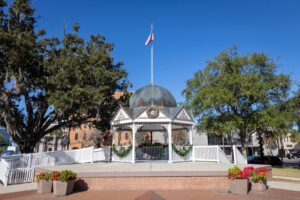
Today we would like to talk to you about the US Census.
No, wait! Hear us out. This is good stuff, we promise.
We know – the word “census” doesn’t exactly conjure up feelings of excitement and enthusiasm. It’s so mundane and boring, even the US Government can only look it in the face once every ten years. It returns every ten years in the form of apprehensive-looking contracted workers knocking gingerly on front doors across America, doing their level best to exhort citizens into answering a few brief questions for the betterment of their respective communities. Hannibal Lecter established himself as an immediate anti-hero when he spoke nostalgically of fava beans and Chianti, and for a brief moment represented the exasperation of a population’s pique at the pedantry of bureaucracy.
The census asks particular questions about health coverage, accessibility, employment rates, schools, educational resources, roads, bridges, and transit access. Other elements identify property values and whether you own or rent, so that analysts can determine if there’s adequate, affordable housing provided, as well as decide where funds and assistance can do the most in housing programs. It all makes a big impact not just on the real estate market, but the overall economic health and future prospects of a community.
 All of these surveys and research are collected into a mountain of data that helps produce statistics about market values in different regions, which is essential in determining which areas need the most assistance and where federal resources can do the most good. That folds into each community’s ability to have a more accurate picture of future growth and make development plans: How big are they going to get, and what resources will be required to make sure as many people as possible get what they need?
All of these surveys and research are collected into a mountain of data that helps produce statistics about market values in different regions, which is essential in determining which areas need the most assistance and where federal resources can do the most good. That folds into each community’s ability to have a more accurate picture of future growth and make development plans: How big are they going to get, and what resources will be required to make sure as many people as possible get what they need?

Ocala’s location, being central to just about everything else in the state and saddled next to major highway arteries for easy access and transport, makes it a top contender for building and relocation. Large companies and corporations use data from the census to strategize and determine where to put down stakes for business and market their products and distribution – which means job growth and opportunities for those key regions. Just last year, Signature Brands opened an expanded warehouse facility that kept their operation in the area, rather than having to move elsewhere. Large brands like Chewy, Amazon, FedEx and McLane also opted for facilities here, and with them came new jobs and economic growth. Companies in the Ocala Metro area can deliver products to 39% more customers than their competitors on the I-4 corridor, and labor costs are nearly 8% lower by comparison as well.
And if the pot couldn’t be sweetened any more, the operating costs in the Ocala Metro area are more affordable; according to the Cushman-Wakefield study, rents are also 28% lower in the Ocala region than in the I-4 corridor, which is a pretty big economic incentive. People can move here, get a job, and keep their fuel costs and mileage down because they don’t have to commute to work.
 Yes, some of this happens without the census, but the census makes it easier for them to happen, and for the choices to be made more decisively and efficiently. It allows market analysts to track growth and migration patterns, housing and property values, and figure out where they’ll take their businesses, build homes, or in the government’s case – where to direct economic and education programs in high-density, high-growth places. Without that ten-year sortie out into the annals of American neighborhoods – both rural and urban – it would be a much more labor and time-intensive process to figure those things out. You can’t be counted if you count yourself out.
Yes, some of this happens without the census, but the census makes it easier for them to happen, and for the choices to be made more decisively and efficiently. It allows market analysts to track growth and migration patterns, housing and property values, and figure out where they’ll take their businesses, build homes, or in the government’s case – where to direct economic and education programs in high-density, high-growth places. Without that ten-year sortie out into the annals of American neighborhoods – both rural and urban – it would be a much more labor and time-intensive process to figure those things out. You can’t be counted if you count yourself out.
The census makes a big difference in how the successive ten years unfold for our homes and families – from quality of education, to whether or not the potholes in the road get fixed and upgrade the value of the neighborhood. The quality of the upkeep is based in part on census numbers, and that directly impacts the value of property and homes – which in turn affects financial health and security for everyone.
The Census Bureau keeps records of its data for two decades on the official site, after which they turn the data over to the National Archives, which has records going all the way back to the 1700s. You can search the census online; it’s free, and anyone can use it. It’s a stunning trove of practical data that gives information about population tracking shifts, economic factors, housing and property, and large employer migrations. If you’re looking to make a location change or just want to check out different property markets, that’s there too. You can even filter and search for specific demographics locally by state or city.
 The National Archives is also a fantastic resource for family genealogy and records. You might find out where your great-grandfather sold a tract of land in New York and moved to Iowa, and with the data available, even figure out why he moved. Both sites are a virtual playground for any research, history, and data nerd, with so much unexpected information, even a non-nerd will find it fascinating and useful. Go have a look and explore it. We promise you’ll have fun, and you’ll probably end up bookmarking the page.
The National Archives is also a fantastic resource for family genealogy and records. You might find out where your great-grandfather sold a tract of land in New York and moved to Iowa, and with the data available, even figure out why he moved. Both sites are a virtual playground for any research, history, and data nerd, with so much unexpected information, even a non-nerd will find it fascinating and useful. Go have a look and explore it. We promise you’ll have fun, and you’ll probably end up bookmarking the page.
So maybe hold off on the fava beans the next time that beleaguered census worker comes around in 2030. But keep the Chianti.